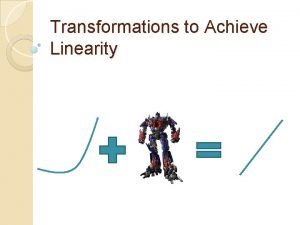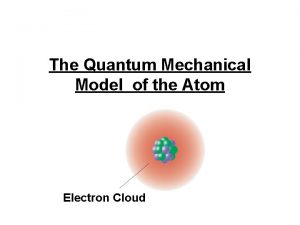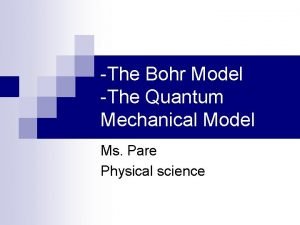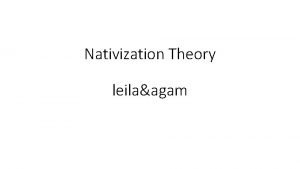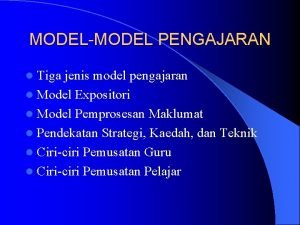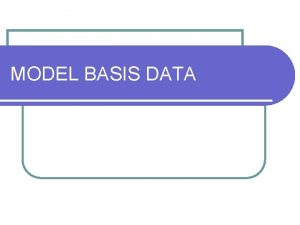Model 1 V 0 Model 2 V Model











- Slides: 11

Model 1 V = 0 Model 2 V Model 3 V and rf Load Line ID vs VD Forward Biased, DC Analysis At 300 K VT = 0. 026 V Thermal equilibrium, depletion region Reverse Biased PN junction AC Analysis Must perform DC Analysis first to get DC diode current, ID Calculate rd = VT / I D photodiode Other types of diode CHAPTER 2 Schottky Barrier Diode Solar cells LED Zener Diode

Multiple Diode Circuit Range of power supply Voltage Regulator Zener Diode CHAPTER 3 The load resistor sees a constant voltage regardless of the current

Derive input load line, IB versus VBE Formulas KVL at BE Loop DC Analysis npn KVL at CE Loop pnp Bipolar Junction Transistor Cutoff Mode of operation CHAPTER 4 Derive output load line, IC versus VCE Active Saturation What happened to each junctions?

Fixed Biasing Circuit Collector to Base Feedback Resistor Voltage Divider Biasing Circuit Bipolar Junction Transistor (Biasing) CHAPTER 4 CONTINUE DC Analysis Voltage transfer characteristic, VO versus VI

Because of the bypass capacitor, emitter becomes grounded Perform DC Analysis first to obtain DC collector current, IC Small Signal Parameters Bipolar Junction Transistor (AC Analysis ) CHAPTER 5 Common Emitter With Resistor at the Emitter terminal grounded Bypass capacitor, CE

Rearrange Common Collector Output resistance Bipolar Junction Transistor (AC Analysis ) CHAPTER 5 CONTINUE Or use the test voltage method

Assume in saturation: calculate ID Formulas KVL at GS Loop DC Analysis NMOS Confirm your assumption PMOS Field Effect Transistor CHAPTER 6 Differences between MOSFET and BJT Mode of operation Cutoff KVL at DS Loop to find value of VDS Calculate VDS sat or VSD sat VGS < VTN or VSG < |VTP| Non saturation Saturation Derive output load line, ID versus DS VGS > VTN or VSG >|VTP| with small VDS or VSD VGS > VTN or VSG >|VTP| with large VDS or VSD

Because of the bypass capacitor, source becomes grounded Perform DC Analysis first to obtain DC drain current, ID Small Signal Parameters Field Effect Transistor (AC Analysis ) CHAPTER 7 Common Source With Resistor at the Source terminal grounded Bypass capacitor, CS

Rearrange Common Drain Output resistance Field Effect Transistor (AC Analysis ) CHAPTER 7 CONTINUE Or use the test voltage method

IDQ

Answering the questions • There are 5 questions. Answer all. • Organize your thoughts. When it is organized, so will your workflow. – Messy work will make the lecturers feel annoyed as they have to look for your answers – bear in mind that lecturer handling one section = 50 -60 students – each paper has 5 questions – TOTAL – 250 to 300 questions to mark • Don’t leave a question blank – just write down anything you know that might be related • Study smart, pray and tawakal.
 What is the concentric zone model
What is the concentric zone model Hilda taba model grassroots approach
Hilda taba model grassroots approach Power model vs exponential model
Power model vs exponential model Mapping of er model to relational model
Mapping of er model to relational model Quantum mechanic model
Quantum mechanic model Bohr model vs quantum model
Bohr model vs quantum model Nativization model theory
Nativization model theory Motivasi model tradisional
Motivasi model tradisional Model ekspositori
Model ekspositori Model model pelatihan
Model model pelatihan Suatu skema atau kerangka kerja yang disederhanakan
Suatu skema atau kerangka kerja yang disederhanakan Model model etika profesi
Model model etika profesi


